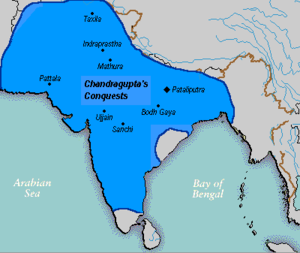Kalinga War
| The Kalinga War | |||||||||
|---|---|---|---|---|---|---|---|---|---|
| |||||||||
| Belligerents | |||||||||
| Maurya Empire | Kalinga | ||||||||
| Commanders and leaders | |||||||||
| Ashoka the Great | Rani Padmavati (presumed) | ||||||||
| Strength | |||||||||
| Total 400,000 |
60,000 infantry,[1] 1,000 cavalry,[1] 700 war elephants[1] | ||||||||
| Casualties and losses | |||||||||
| 100,000 |
200,000+ (exaggerated figures by Ashoka himself)[2][3] (including civilians) | ||||||||
The Kalinga War was fought between the Mauryan Empire under Ashoka the Great and the state of Kalinga, a feudal republic located on the coast of the present-day Indian state of Odisha and northern parts of Andhra Pradesh. The Kalinga war, the only major war Ashoka fought after his accession to throne, is one of the major and bloodiest battles in world history. Kalinga put up a stiff resistance, but they were no match for Ashoka's brutal strength. The bloodshed of this war is said to have prompted Ashoka to adopt Buddhism. However, he retained Kalinga after its conquest and incorporated it into the Maurya Empire.[4]
Background

The main reasons for invading Kalinga were both political and economic.[5] Since the time of Ashoka's father, King Bindusara, the Mauryan Empire based in Magadha was following a policy of territorial expansion. That was considered a great setback for the traditional policy of territorial expansion of the Magadhan emperors and was considered to be a loss of political prestige for the Mauryas
merely imperative to reduce Kalinga to complete subjection. To this task Ashoka must have set himself as soon as he felt he was securely established on the throne.Cite error: The <ref> tag has too many names (see the help page). The war began in the 8th year of Ashoka's reign, probably in 261 BC. Ashoka's grandfather Chandragupta had previously attempted to conquer Kalinga, but had been repulsed. After a bloody battle for the throne after Bindusara's death, Ashoka tried to annex Kalinga. Ashoka was successful only after a savage war, whose consequences changed Ashoka's views on war and led him to pledge never to wage a war of conquest.
It is said that in the aftermath of the Battle of Kalinga the Daya River running next to the battle field turned red with the blood of the slain; more than 150,000 Kalinga warriors and about 100,000 of Ashoka's own warriors were among those slain.
Aftermath
Asoka had seen the bloodshed with his own eyes and felt that he was the cause of the destruction. The whole of Kalinga was plundered and destroyed. Asoka's later edicts state that about 100,000 people were killed on the Kalinga side and almost equal number of Asoka's army. Thousands of men and women were deported. Asoka after seeing this was filled with sorrow and remorse.
Asoka's response to the Kalinga War is recorded in the Edicts of Asoka. The Kalinga War prompted Asoka, already a non-engaged Buddhist[citation needed], to devote the rest of his life to Ahimsa (non-violence) and to Dharma-Vijaya (victory through Dharma). Following the conquest of Kalinga, Ashoka ended the military expansion of the empire, and led the empire through more than 40 years of relative peace, harmony and prosperity.
- "Beloved-of-the-Gods, King Priyadarsi, conquered the Kalingas eight years after his coronation. One hundred and fifty thousand were deported, one hundred thousand were killed and many more died (from other causes). After the Kalingas had been conquered, Beloved-of-the-Gods came to feel a strong inclination towards the Dhamma, a love for the Dhamma and for instruction in Dhamma. Now Beloved-of-the-Gods feels deep remorse for having conquered the Kalingas." Rock Edict No.13[6]
According to oral histories, a woman approached him and said, "Your actions have taken from me my father, husband, and son. Now what will I have left to live for?" Moved by these words, it is said, that he accepted/adopted Buddhism, and vowed to never take life again.
References
- ^ a b c Pliny the Elder (77 AD), Natural History VI, 22.1, quoting Megasthenes (3rd century BC), Indika, Fragm. LVI.
- ^ Ashoka the Great (r. 272–231 BC), Edicts of Ashoka, Major Rock Edict 13.
- ^ Radhakumud Mookerji (1988). Chandragupta Maurya and His Times. Motilal Banarsidass Publ. ISBN 81-208-0405-8.
- ^ "Detail History of Odisha".
- ^ Ramesh Prasad Mohapatra(1986) Page 10. Military History of Orissa. Cosmo Publications, New Delhi ISBN 81-7020-282-5
- ^ S. Dhammika, The Edicts of King Ashoka, Kandy, Buddhist Publications Society (1994) ISBN ISBN 955-24-0104-6 (on line)
